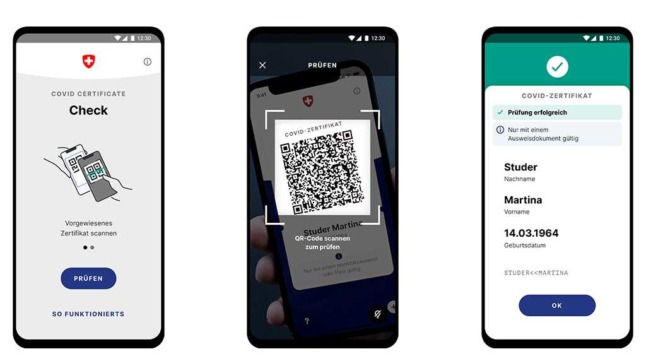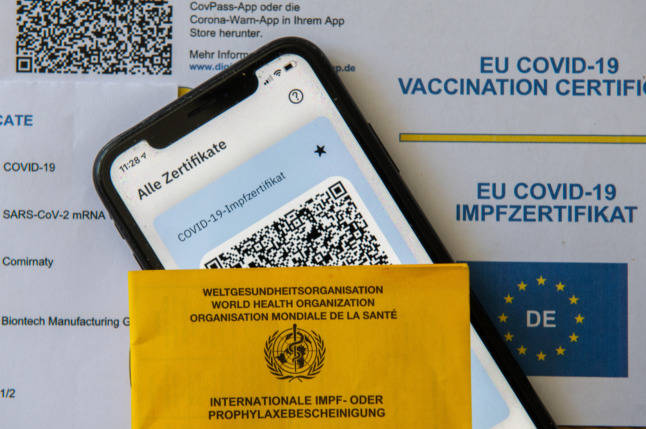The European Union and Switzerland will recognise each other’s Covid vaccination certificates from Friday, July 9th.
This month, 27 EU member states along with Iceland, Norway and Liechtenstein adopted common standards to read digital coronavirus certificates.
Proof of vaccination or acquired immunity via a recognised certificate can help travellers avoid restrictions like quarantine on arrival.
READ MORE: EU agrees to recognise Switzerland’s vaccination certificate
But member states remain in charge of their own border rules, and reserve the right to impose emergency controls if the epidemic situation deteriorates.
Indeed, as the Swiss government emphasises on its official Covid Certificate website, having a valid Covid Certificate is no guarantee of being allowed to enter another state.
What is the Covid Certificate?
The Covid-19 certificate – otherwise known as the Covid-19 pass or the green pass – is available in paper and digital form.
According to the Swiss government, the pass “provides documentary evidence that you have had a COVID-19 vaccination, have had and recovered from the disease or have tested negative”.
What about for travel?
When you test negative, get vaccinated or test positive for the virus, you will receive paper evidence.
Inside Switzerland, you can use this paper evidence as your Covid certificate.
If you would prefer not to carry a piece of paper around, you can scan the QR code into the Covid Certificate app on your device, which you can then use to enter events, nightclubs etc.
The app is free. Here is the link for the Apple App store, and Android.
The one difference between the paper form and the digital form is that if you want to travel in the EU, you may encounter problems with the paper form.
As this has been issued in Switzerland, the QR code may not be recognised in other countries.
The EU has however promised to recognise the Swiss Covid Certificate app in all EU countries. Therefore, if you are heading abroad, scan your QR code into the Swiss app and you are ready to travel.
If for some reason you do not have the Swiss Covid Certificate app, you can scan your Swiss QR code (i.e. from a paper certificate) into the app in several destination countries such as France, Germany and Austria, although this may not last into the future.
Do I need to register the app in each EU state?
No.
As Switzerland’s app is recognised by the EU, this means that you will simply need to use your Swiss Covid Certificate app and it will be recognised abroad.
Do the same rules apply as in Switzerland?
No. Although the pass will be recognised throughout the EU, the rules in place in the destination country apply rather than those in Switzerland.
This means, for instance, that there may be a different time period in which you are considered to be fully vaccinated in a destination country.
For example, Austria recognises immunity 22 days after the first dose of vaccine – rather than 14 days after the second vaccine, as is the case in Switzerland.
There will also be different rules domestically regarding restaurants, events etc, so be sure to check with your destination country.
What about for visiting Switzerland?
People from EU states can display their app in Switzerland as the two systems are mutually integrated with each other.
Have there been problems or hiccups in the rollout?
Using the app in Switzerland and abroad can require you to show ID, as officials will want to know that you are the person mentioned on the app.
Swiss media has reported that some users have faced problems when the names on the certificate do not line up with the names on ID presented, for instance where a maiden name was used or where a middle name is missing.
Therefore, the Swiss Federal Office of Public Health has encouraged everyone to make sure the data appearing on both is identical, otherwise problems may ensue.
If you find that there are different names on each or other details do not line up, you are encouraged to contact your vaccination centre to have the issue rectified.
What is the Covid immunity pass?
This passport, in the form of a QR code on a smartphone or printed out on a piece of paper, must be presented by each traveler at the border.
It includes identification data and information relating to vaccination (type of vaccine, number of doses received), screening (date of test, negative or positive result), and even serological analysis, namely if the traveler had Covid and has antibodies.
READ MORE: How to get Switzerland’s Covid-19 health pass
Switzerland’s Covid-19 immunity certificate has been available since June 7th – and now has a linked app which makes the digitalisation process easier.
Both apps are available for free. Here is the link for the Apple App store here, and that for Android. 
Switzerland’s Covid-19 certificate app up close. Image: FOPH



 Please whitelist us to continue reading.
Please whitelist us to continue reading.
Member comments